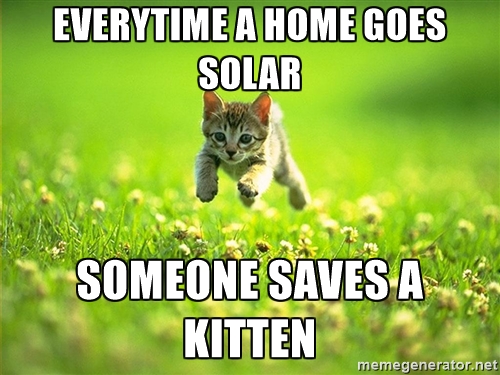
Don’t you hate articles with pictures of cute babies or kittens to lure you into a discussion about something boring like auto insurance or retirement planning?
Maybe they use a kitten GIF like this one (with a puppy thrown in here for extra credit):
I promise that this will not be one of those articles!
Instead, here you’ll get real value about two very different and important subjects — both solar power and cats.
And you should definitely share it with your kids. Almost everyone loves cats, so it’s just fun for parents and kids alike to talk about them together. But it’s also serious. Learning about pets helps teach science. It’s also key to developing good social skills and ethics, especially a healthy respect for animals.
And solar? If you want your kids to grow up and become citizens informed on energy, one of the most important topics for America and the world in the coming years, this article will help you talk about energy in a fun way.
But first, here’s another kitten GIF, just to set the right tone:
So, let’s get started. Below you’ll find five fun facts about cats from The Science Kids website. After each one, I’ve added some fun facts of my own about solar power. And of course, a kitten gif. Enjoy!
1. Cats are one of, if not the most, popular pet in the world
People love solar power almost as much as they love cats. Solar is by far the most popular energy source in the world and across the United States. A Gallup poll taken in 2015 shows solar topping the list of American energy sources that people say need more attention. Solar stood out, with 91% of respondents saying the US should place more emphasis, or the same emphasis as now, on getting more solar. Wind was #2, oil was in the middle of the list. At the very bottom of the list was coal. No wonder that’s what bad kittens get in their Christmas stockings.
2. There are over 500 million domestic cats in the world
Today, solar power produces just over 1% of the world’s electricity. Since solar is the world’s fastest growing energy source, you can expect that number to increase quickly in the coming years. Meantime, how much land would it take to power all the families in different countries who take care of so many cats? Believe it or not, but a really small area, just the size of the country of Spain or the state of California, would hold enough solar panels to make enough power for the whole world.
Of course, getting all that electricity to people where they need it in their homes in different countries is another matter. What about putting solar panels on the collars of those 500 million cats?
3. Cats and humans have been associated for nearly 10,000 years
And humans have been using power from the sun for more than 10,000 years. “Ancient Greeks and Egyptians, as well as Native Americans, built homes and cities to have the most energy efficient sun exposure. They faced their buildings south, like we do with our solar panels,”as VA Sun explains. In 1839, French Physicist Alexandre Edmond Becquerel discovered the photovoltaic (PV) effect, the way to make electricity from the sun.
The modern solar panel made from silicon was developed in the 1950s at Bell Labs. Silicon is also used in computer chips. And silicon is the main ingredient of the sand you find on the beach or in a sandbox at a playground. But you won’t find it in a cat’s litter box, because that’s usually filled with a special kitty litter to make things smell better.
4. Cats conserve energy by sleeping for an average of 13 to 14 hours a day
And while cats sleep most of the time, just like humans, you can say that solar panels “sleep” at night. Solar panels only work when the sun is shining and they don’t produce power in the dark. In the US, solar panels make energy for 5-8 hours a day on average over the whole year. Of course, solar panels produce more energy during the summer when there’s more sun per day.
And where your solar panels are installed makes a big difference in how much power they produce in different seasons. For example, in Alaska, the winter is not just very cold. It’s also very dark, with short days and long nights. This means that in January in Alaska, a small home solar system (2.6 kW) can produce all the power a family needs in June. But in January, the same solar panels produce only enough power to run a single coffee pot.
5. On average cats live for around 12 to 15 years
Solar panels can be said to “live” about twice as long as cats. Though most solar panels come with a warranty of 25 or 30 years, solar panels can produce energy for 40 years or more. But just like cats, as they get older, solar panels do get less “energetic,” so to speak. Solar panels can lose about half of one percent (0.5%) of their ability to make power each year according to research by the US government’s National Renewable Energy Laboratory. But even after 25 years, that means a solar panel will still produce about 85% of the energy it did when it was brand new. I think most cats would say that’s pretty good.
And, there are exceptions. You may know a 12-year-old cat that seems to be able to jump as high as ever. Well there was a solar panel owned by a man in Vermont that was making more energy after 30 years than it did when it was new.
By the way, a solar panel more than 25 years old has an age of more than 116 cat years, according to this online cat-year calculator.
— Andrew Brenner, Main Street Solar





